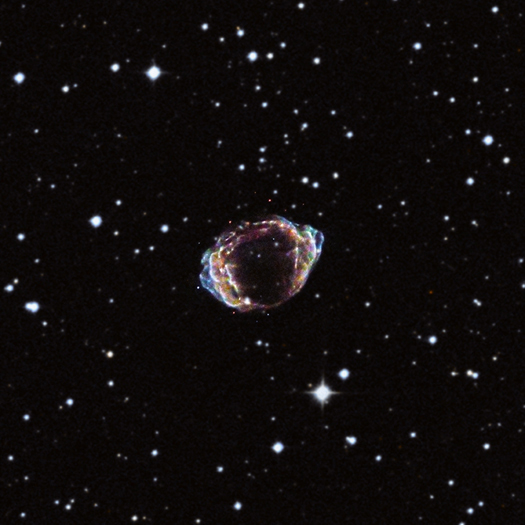Every so often a zoo announces that one of its rare, prized animals — a snow-leopard, say — has given birth.
A couple of weeks later the offspring is revealed to the public, looking cute and fluffy.
Our Galaxy, too, has been coyly hiding some of its “offspring”.
In 2008 astronomers discovered that, about a hundred years ago, our Galaxy had had a “happy event” — a star exploding as a supernova.
This is the most recent supernova known to have occurred in our Galaxy.
It’s a mere 28,000 light-years from Earth — just a stone’s throw, in astronomical terms — towards the Galactic centre.
We didn’t see it when it was born, because it was so heavily obscured by dust in space. (That dust, by the way, is produced by stars during various stages of their lives, and is made of very fine particles, like cigarette smoke.)
But now the face of this supernova remnant “kitten” has been revealed by NASA’s Chandra X-ray telescope.
The newly revealed supernova remnant, called G1.9+0.3. This new image is a composite made with NASA’s Chandra X-ray space telescope: low-energy X-rays are red, intermediate energies are green, and higher-energy ones are blue. Also shown are optical data from the Digitized Sky Survey, with stars appearing in white. Credit: X-ray (NASA/CXC/NCSU/K.Borkowski et al.); optical (DSS).
Being so close, this supernova remnant gives us a ringside seat for studying what’s going on in these explosions.
The star that exploded was probably a white dwarf. It either dragged matter off an orbiting companion star, or merged with another white dwarf — both of them fatal actions. (This particular type of supernova, which astronomers call Type Ia, is used as a distance indicator, because they are all of very much the same brightness.)
Astronomers are interested in finding “hidden” supernovae in other galaxies as well, because they want to match up the numbers of star births and deaths. (It’s embarrassing if some of your population simply goes missing.)
And besides, even if they’re not fluffy, some of the young ones are very cute.



1st July 2013 at 8:07 pm
Is there a higer resulution picture available? I would like to add the picture to my “astronomical” pictures desktop theme.
Dror
3rd July 2013 at 2:24 pm
There are a whole gallery of images of this beautiful supernova remnant available at the Chandra Xray Space Telescope website.http://www.chandra.harvard.edu/photo/2013/g19/